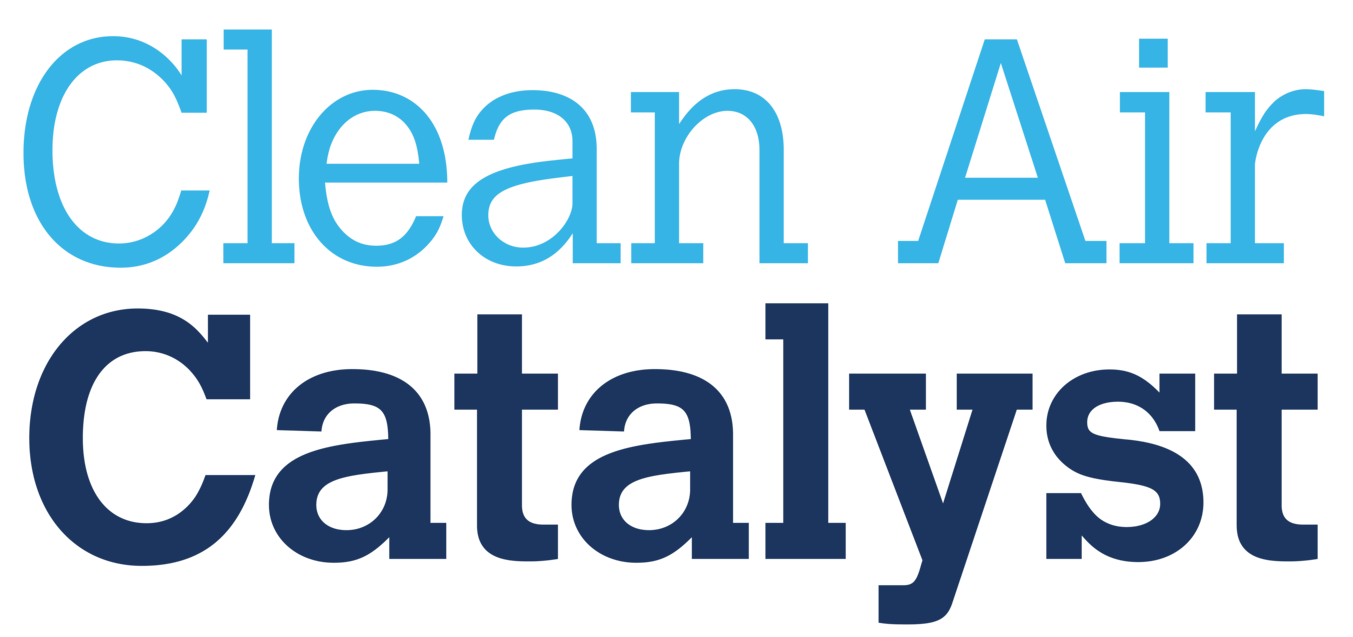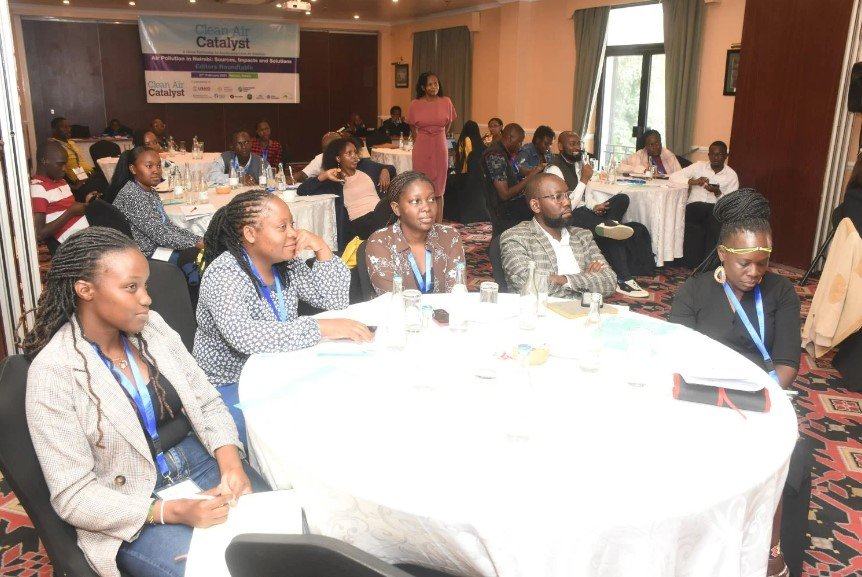EJN Workshop Trains 49 Journalists and Editors to Cover Air Pollution in Nairobi, Kenya
Thirty-one journalists receive a certificate of participation after completing a two-day media workshop on air pollution on February 28-29 in Nairobi, Kenya / Credit: Stella Paul.
This article was first posted on earthjournalism.net on March 25, 2024.
Air pollution is one of the biggest threats to human health, economy, and the world's ecological balance. In the Kenyan capital of Nairobi, studies have shown that air quality is consistently poor, with average annual PM2.5 levels—a measure of air pollution—more than double the World Health Organization's (WHO) guideline levels. Furthermore, the ever-increasing population and the intensification of industries, deforestation, construction work, and vehicular traffic, has caused the air quality to worsen over the years.
The media is critical in informing the public, shaping perceptions, and driving policies related to air pollution. Journalists can stimulate community-level dialogues and help create enabling environments for policies. Mainstream media, community media as well as social media can reinforce key messages on air pollution and bring about greater accountability and behavioral change.
However, business pressures within Kenya have limited the types of topics covered in media, while the complexity of air quality and air pollution itself makes it difficult for journalists to cover these stories.
To address this gap, Internews’ Earth Journalism Network, through its Clean Air Catalyst project, organized a training for editors and journalists in Nairobi from February 27-29. Titled “Air Pollution Sources, Impacts, and Solutions — How to Report on Them” the training included a day-long editors’ roundtable followed by a two-day workshop for journalists. Both events focused on strengthening the capacity of local media to report on air pollution in Nairobi and deepen public understanding of the sources, impacts, and solutions of air pollution.
Editors' roundtable
On February 27, 18 participants from the city’s leading TV, radio, print and digital media outlets attended the editors' roundtable. These included editors from environmental, health, technology, science, and sustainable business desks.
"In 2023, EJN conducted a study to gauge the regularity and pattern of air pollution reporting in Kenyan media and our key findings were that only a handful of media stories are published on the subject and none of these are in-depth in nature. We also found that almost all media outlets face multiple challenges while reporting about air pollution which include lack of knowledge and understanding of the issues, lack of access to resources and data,” said EJN project officer for environment and health, Stella Paul.
“Guided by these findings, we have been organizing media trainings and this is our third training. However, it’s the first time that we have brought editors to the table of discussion as they have the power to ensure better coverage of the subject and publish more stories about air pollution,” she explained.
Participants speak at an interactive session of the editor's roundtable / Credit: Stella Paul.
Two-day workshop
Following the editors' roundtable, EJN hosted a two-day media workshop attended by 31 full-time and freelance journalists from 26 media outlets, including general news dailies, business publications, health talk shows and current affairs magazines. Half of the participants were women.
The workshop featured trainers from EJN and local media; the speakers were subject experts from the Clean Air Catalyst consortium in Kenya, local academia, Nairobi County government and USAID. They included:
Stella Paul — Environment and Health Project Officer, Internews’ Earth Journalism Network
Jackie Lidubwi — Clean Air Catalyst Project Coordinator, Internews’ Earth Journalism Network
Judy Mutheu — Data and Social Media Expert, Conversation Africa
Beth Elliott — Communications and Engagement Lead, Clean Air Catalyst, WRI
Maurice Kavai — Deputy Director, Climate and Air Quality, Nairobi City County Government
Purity Munyambu — Gender Specialist, WRI Africa
Paul Njogu — Lecturer, Jomo Kenyatta University of Agriculture and Technology
Sami Simiyu — Consultant, Vital Strategies
Victor Nthusi — Consulting Research Fellow, Health Effects Institute
Gideon Lubisia — Engineer, AirQo
The workshop saw speakers from the CAC consortium and partner entities share information about the Clean Air Catalyst project and its aim to mobilize clean air solutions to improve air quality in Nairobi. Several speakers pointed out that although there has not been enough research done to identify different hotspots in Nairobi yet, there is still enough data to prove that the city’s current air quality status is far below what WHO recommends. They called on participants to report on the health impacts of the city’s air quality with a science-backed approach.
In a special address at the workshop, Maurice Kavai, representing Nairobi County, highlighted collaborative efforts with Clean Air Catalyst to combat pollution.
Beth Elliott from World Resources Institute also provided valuable insights into the Clean Air Catalyst program’s global initiatives, emphasizing the role of cities in providing clean air solutions, particularly in Sub-Saharan Africa, while Dr. Paul Njogu from Jomo Kenyatta University of Agriculture and Technology spoke about historical pollution trends and their health impacts, emphasizing the media’s critical role in raising awareness.
Media workshop participants in an interactive session / Credit: Stella Paul.
Sami Simiyu of Vital Strategies explained to the participants the serious health impacts of poor air quality. Victor Nthusi from Health Effects Institute led discussions on effective reporting strategies, focusing on case studies and sustained interventions, while gender specialist Purity Munyambu highlighted gender disparities in air quality vulnerability, stressing the importance of gender-sensitive reporting.
On the last day of the workshop, Judy Mutheu led a session on data journalism and social media. She emphasized the integration of data in journalism and the power of visualization for impactful air quality storytelling and demonstrated use of open data tools that can be accessed free of cost. Additionally, she guided participants to explore sources for air quality data and strategies on social media. She explained how social media platforms could be leveraged for story gathering and dissemination, encouraging collaboration and audience engagement.
Finally, Stella Paul led journalists in an in-depth exercise to develop concrete, engaging, relevant and gender-sensitive pollution story ideas. Divided into groups, journalists worked collaboratively to build out story ideas that trainers then shared constructive feedback on.
Reflections
The editors who participated said they have a newfound understanding of air quality issues and their societal impact.
“The training has been very revealing: it helped me better understand the stereotypes that we allow and how these can be challenged. This will help change our reporting approaches regarding air pollution”
Positive feedback was also received from journalists who said that this training was the first such opportunity to learn about air pollution in their city. “I used to think that a story about air pollution should be all about data and graphs because it’s a science story and for a niche audience. So, I used to doubt if this was something I can report about since I write for a wider audience. But this training, especially the story idea development session has made me realize that one can report air quality stories from multiple angles and even if there is not a lot of hard data, we can still cover the issue from the ground and raise public awareness,” said Joyce Chimbi, a senior journalist from Talk Africa.
Several participants thanked EJN for connecting them with air quality experts at the training; they flagged the need for air pollution terminology to be translated into local languages. “If we could have some of the terms translated into local language, it could help us reach a wider audience,” commented Alex Kirare, an editor from the Standard Media Group.
The training ended with journalists receiving a certificate of participation from the speakers and trainers.
As part of this training opportunity, some journalists will be awarded story grants to report on air pollution issues in Nairobi. Look out for their stories on the EJN website in the coming months.



